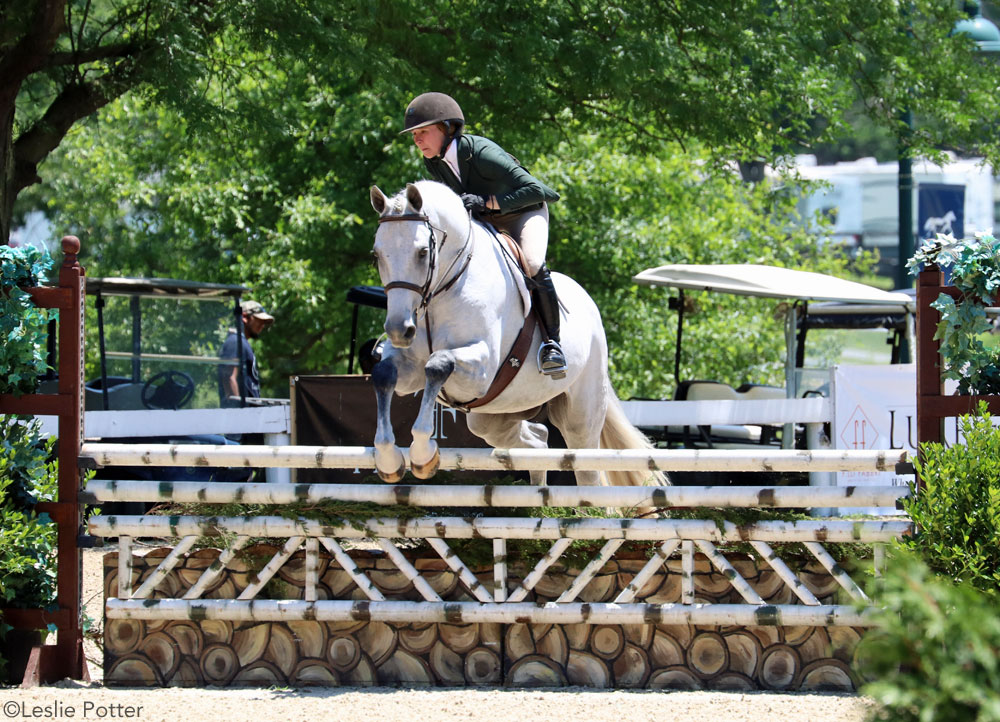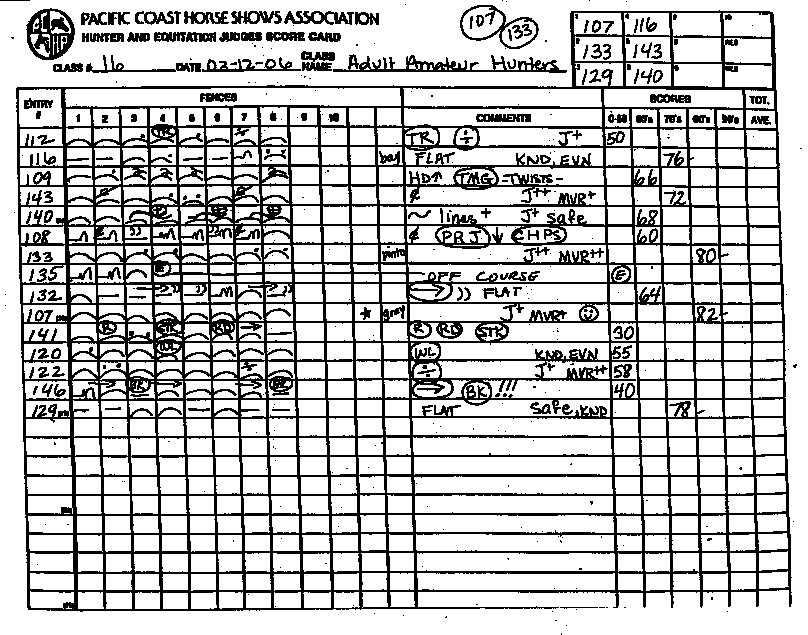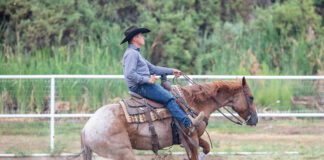
“The judge just doesn’t like my horse.” Unfortunately that’s a common rationalization when a rider is perplexed about her horse’s lack of a ribbon in a hunter class. However, a prejudicial judge isn’t usually the problem. Instead, it’s often a lack of understanding about how hunters are evaluated and how the judge actually keeps score.
Clarifying Criteria
Each fence should also be jumped from a consistent take-off distance. A tiny stride added at the base of the jump—known as a “chip”—interrupts the flow of the performance. The horse’s pace is also important, as it is a reflection both of manners and ability. A horse that is rambunctiously raring to go is not representative of a pleasant mount to ride. And if a hunter cannot make it through the lines on a course in the prescribed number of strides without launching into warp drive, he probably doesn’t possess the long, ground-covering step that is sought after in show-ring competition.
With so much going into evaluating a show hunter’s performance, it seems like there should be a wealth of information jotted down on the judge’s scorecard.
“I’ve had classes with 110 hunters, each one needing a score. There isn’t time to write a chapter of comments for each horse. It’s impossible! As soon as one horse finishes the last fence, the next horse comes into the arena,” explains Meredith Kistler, a United States Equestrian Federation hunter judge since 1981.
As a result, hunter judges develop their own shorthand: a collection of cryptic slashes, dots, acronyms and hieroglyphics that mean something just to them. That way, they can quickly make their notations as the horse goes around the course. At a glance, they can decipher how they arrived at that horse’s score, if an exhibitor should ask. Being forced to ask the judge to untangle the web of mysterious markings has a benefit, Meredith says.
“I know that at the bigger shows, riders are not really able to approach the judge. But I think that at smaller shows, as long as they go through the show manager or the steward, competitors should take the opportunity to ask the judge what they might do better next time. It helps them become educated competitors. I can explain my marks in a way that isn’t offensive. As a judge, I never want to insult the exhibitor. It costs a lot of money to walk into the arena and ride in front of me. The last thing I want to do is come off as condescending.”
Hence, Meredith focuses on noting positive things about each horse.
“One comment I might make for a hunter is, ‘rider tense/horse still soft’ because it reminds me that even though, for example, a novice rider seemed a little scared or apprehensive, the horse did his job quietly and took care of his rider. That’s a great quality in a hunter for that level of rider.”
Meredith believes that as exhibitors become more educated, they’ll cease resorting to excuses like their belief that the judge has something against their horses. “Oh, I’ve overheard comments, such as ‘She doesn’t like my horse because he’s gray; she doesn’t like gray horses.’ That’s not true. I owned a wonderful gray hunter. I love grays. But the rider still has to come into the arena and put in a decent trip.”
Meredith even offered how sometimes she sits in the judge’s booth and can’t help but quietly ride along with the exhibitor.
“Sure, I’ll see a horse come in, start on course, and think, ‘Oh, I like him.’ And then the rider will get him to a horrible take-off spot. Or he’ll look at a jump and stick off the ground, and I’ll think, ‘Oh, don’t do that!’ ”
So it’s not favoritism that decides the ribbons in a hunter class. More often, it’s ability.
Report Card
Meredith offers a glimpse at a typical hunter scorecard. Along the far side is a spot to note the exhibitor’s number. Next to that is a row of boxes where she scribbles marks signifying how the horse jumped each fence. Following that is a blank space where she has a chance to record anything particularly noteworthy about that horse’s performance. All of this information results in a numerical grade, which is placed in the last row of boxes beneath the appropriate column of potential scores. Although it seems that the numerical score is subjective, it really isn’t.
The hunter round is being awarded a holistic score based on the overall impression, with 100 being the perfect score. In fact, there have been a few scores of 100 at major hunter competitions, although they are very rare.
“There are automatic scores for major faults,” Meredith says. “There may be a discrepancy between judges of a few points, but basically we all score major faults the same. A rail down in a hunter class is an automatic 55. If a horse breaks the canter and trots on course, it’s a 50. A refusal gets you a 30.”
All of these scores are analogous to getting a D or an F on a test in school signifying that you need to study harder because you aren’t making the honor roll. Meredith says that there are “little things” that also keep a hunter out of the ribbons in a large class.
“While a baby green hunter might be forgiven for skipping through a lead change, where they take a step behind at the trot to catch up onto the correct lead, in any other hunter class that would be seen as trotting on course, and be scored as a 50.”
Another lead change problem that might go unnoticed by a rider? “A horse that swaps his lead in front of the jump,” Meredith explains. “That’s hard for most riders to feel. They think they’ve put in this wonderful round, and can’t understand why they didn’t pin, but unless they had someone knowledgeable on the rail watching their round, they won’t know what I saw.”
That scenario leads to one of Meredith’s pet peeves, echoed by other judges. “Unless educated exhibitors have a good understanding of how their horses performed, and then saw every other round in the class, they really can’t make disparaging comments about the judging.” Each horse is, after all, judged against an ideal standard, “but ultimately ea ch horse is being compared to the other horses in that particular class.”
In the event of nearly equal scores, what determines which color of ribbon goes to which horse?
“Often, the only thing separating the top five or six horses in a big hunter class is a couple of points. That’s it.” Meredith recounts how she sometimes has to split points to end up with scores like 80.50 and 80.25, respectively, to decide between two ribbons. “So an exhibitor may be left thinking she was out of the ribbons by a wide margin, when actually she missed being pinned by just a couple of points.”
A horse can gain that half a percentage point primarily through an intrinsic factor that Meredith sums up as, “being a quality animal. I don’t mean that to sound negative against other horses in the class, but some horses simply have that extra something that makes them stand out and grab the judge’s eye. It comes through in their overall appearance. They’re the kind of horses that come into the arena, and I can’t help but sit up and watch them. In a pinch, that might be the deciding factor.”
These comments come across as polite niceties in a competitive world where other hunter judges have an arsenal of marks such as “FWD” to denote an awkward jump that was a Flirtation With Death, or “911” for a horse that suddenly bolts off the ground. When asked how she maintains a reputation as an amicable judge, Meredith believes that it may be because she still competes in the hunter division herself. “I ride a couple times a year in the adult amateur division on my horse, No Regrets. It reminds me what it’s like to compete. Riders get nervous before they start on course. They may have a bad warm-up that leads to a bad round. That’s one reason why I don’t hold grudges when I judge. I don’t see a particular horse come into the arena and think, ‘Here comes that horse that always does X, Y or Z.’ Each class gives a horse and rider a fresh start in my mind. Because I still show hunters, I think I have empathy for what riders go through, for the ups and downs of showing.”

Deciphering Scorecard Scratches
With the help of several United States Equestrian Federation hunter judges, we mocked up a purely hypothetical scorecard for an adult amateur hunter class. Using a combination of marks from the judges’ respective repertoire, you get a glimpse of what’s being jotted down while you’re on course.
A good jumping effort is marked as a simple half-moon shape. If the horse happens to rub the rail, a dot is placed denoting whether it was the front or hind legs that rubbed. A straight line symbolizes a flat jumping effort, where the horse jumped without an arc (bascule), a stylistic fault. The symbols of two commas or a little curlicue mean that the horse jumps with loose front legs or worse, that he twists in the air with his body. Both are major style faults that could be dangerous.
Abbreviations are rampant. “TR” means the horse trotted on course. A wavy line ~ says the horse has a habit of weaving or drifting in lines of jumps. Did the horse add a stride in the line? That gets a plus mark. The letter “C” with a slash denotes a cut corner. “WL” is “wrong lead”; “BK” means the horse bucked; “STK” is used if the rider resorts to a smack of the crop; “TMG” refers to an overly tight standing martingale (generally combined with a symbol for a high head carriage); “PRJ” discreetly means that the horse is an overall poor jumper; and “CHPS” is an abbreviation for “chips,” where a horse stutter-steps at the base of the jump and adds a little hop. If a horse is eliminated—as Number 135 is for straying off course—his scoring ceases and that’s noted with an “E.” As a final observation, judges often circle anything a horse does that’s notoriously bad.
Then there are the good abbreviations, usually on the right side of the comment section. Jumping style is evaluated with the letter “J,” with plus-marks added as warranted. Ditto for the horse’s movement, which is noted by the abbreviation “MVR.” You’ll also see comments about the horse’s temperament or pace whittled down to mere letters.
Occasionally a judge will jot down a horse’s color or apparent breed, and place that next to the comments section. That’s not discriminatory. It’s just another quick reference so the judge can recall a particular horse.
Finally, it all comes down to the numerical score. Keep in mind that there is an unavoidable element of subjectivity in judging hunters, and judges are permitted to use their personal tastes when calculating demerits for anything less than a major fault. Look at the scores for 107 and 133, for example. Both had fairly equal trips. What gave the winner, Number 107, the advantage? While his rival, Number 133, was the better mover and jumper, he rubbed several jumps with his front toes. Not a major concern, but enough to relegate him to second place. Yet those two horses were above the rest of the field, and hence their numbers are circled at the top of the scorecard for a quick reference to the best horses in the class.






This article was awesome!!! It really helped me understand how the judge makes the scores. Now, I shall get a ribbon winning round, now that I know what she/he is looking for! Good luck to every one this year with your showing season of 2007!
So what would an abbreviation of “SMT” be?
Very helpful!
Is there a way I can contact Meredith Kistler?